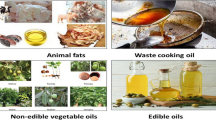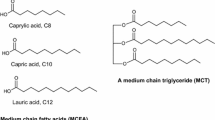Abstract
The products formed by thermally induced isomerization of trilinolein and trilinoelaidin at 250 °C were studied by infrared spectroscopy and gas chromatography. The triglycerides of the 9c12c and 9t12t fatty acids, linoleic and linoelaidic acid respectively, were subjected to thermal treatment under nitrogen in glass. The products were removed at regular intervals and analysed by infrared spectroscopy using a single reflectance attenuated total internal reflectance crystal accessory. Trans-esterification of the products provided the corresponding fatty acid methyl esters which were studied by gas chromatography. The results show that the samples undergo decomposition and isomerization. Thermally induced 9c12c fatty acid (linoleic acid) molecules in the trilinolein molecules isomerize into 9c12t, 9t12c and 9t12t isomers. Thermally induced 9t12t fatty acid (linoelaidic acid) molecules in the trilinoelaidin molecules isomerize into 9c12t, 9t12c and 9c12c isomers. However, the concentration profiles are different for these two triglyceride samples. The rates of formation of isomers from linoleic acid are higher than the rates of formation of isomers from linoelaidic acid. In addition, these two fatty acids also isomerize into conjugated linoleic acids (CLAs). The profiles of the CLAs are identical in both cases.









Similar content being viewed by others
Abbreviations
- GC:
-
Gas chromatography
- FT-IR:
-
Fourier-transform infrared spectroscopy
- ATR:
-
Attenuated total internal reflectance
- CLA:
-
Conjugated linoleic acid
- FAME:
-
Fatty acids methyl ester
- LA:
-
Linoleic acid
References
Mensink RP, Katan MB (1990) Effect of dietary trans fatty acids on high-density and low density lipoprotein cholesterol levels in healthy subjects. New Engl J Med 323:439–445
Zock PL, Katan MB (1992) Hydrogenation alternatives: effects of trans fatty acids and stearic acid versus linoleic on serum lipids and lipoproteins in humans. J Lipid Res 33:399–410
Daush JG (2002) Trans-fatty acids: a regulatory update. J Am Diet Assoc 102:18–20
Stender S, Dyerberg J (2004) Influence of trans-fatty acids on health. Ann Nutr Metab 48:61–66
Judd JT, Clevidence BA, Muesing RA, Wittes J, Sunkin ME, Podczasy JJ (1994) Dietary trans fatty acids: effects on plasma lipids and lipoproteins of healthy men and women. Am J Clin Nutr 59:861–888
Dutton HJ (1979) Hydrogenation of fats and its significance. In: Emken EA, Dutton HJ (eds) Geometrical and positional fatty acids isomers. American Oil Chemists’ Society Press, Champaign, pp 1–16
Christy AA, Xu Z, Harrington PB (2009) Thermal degradation and isomerisation kinetics of triolein studied by infrared spectrometry and GC–MS combined with chemometrics. Chem Phys Lipids 158:22–31
Christy AA (2009) Evidence in the formation of conjugated linoleic acids from thermally induced 9t12t linoleic acid: a study by gas chromatography and infrared spectroscopy. Chem Phys Lipids 161:86–94
Beatriz M, Oliveira PP, Ferreira MA (1996) Capillary gas chromatographic evaluation of trans-fatty acid content of food produced under the traditional conditions of semi-industrial frying. J High Resol Chromatogr 19:180–182
Moreira RG, Castel-Perez ME, Barufet MA (1999) Deep-fat frying: fundamentals and applications. Aspen Publishers, Gaithursburg
Rojo JA, Perkins EG (1987) Cyclic and fatty acid monomer formation in frying fats. J Am Oil Chem Soc 64:414–421
Fullana A, Carbonell-Barrachina AA, Sidhu S (2004) Volatile aldehyde emissions from heated cooking oils. J Sci Food Agric 84:2015–2021
Umano K, Shibamoto T (2001) Analysis of cooking oil fumes by ultraviolet spectroscopy and gas chromatography-mass spectrometry. J Sci Food Agric 49:4790–4794
Fujisaki M, Endo Y, Fujimoto K (2002) Retardation of volatile aldehyde formation in the exhaust of frying oil by heating under low oxygen atmospheres. J Am Oil Chem Soc 79:909–914
Leon-Camacho M, Ruiz-Mendez MV, Gaciani-Constante M, Gaciani-Constante E (2001) Kinetics of the cis-trans isomerization of linoleic acid in the deodorization and/or physical refining of edible fats. Eur J Lipid Sci Technol 103:85–92
Wolff RL (1993) Heat-Induced geometrical isomerization of α-linoleic acid: effect of temperature and heating time on the appearance of individual isomers. JAOCS 70:425–430
Tsuzuki W, Nagata R, Yunoki R, Nakajima M, Nagata T (2007) cis/trans-Isomerisation of triolein, trilinolein and trilinolenin induced by heat treatment. Food Chem 108:75–80
Official Methods and Recommended Practices of the American Oil Chemists’ Society (1989) In: D. Firestone (ed), 4th edn. American Oil Chemists’ Society Press, Champaign
Mossoba MM, Yurawecz MP, McDonald RE (1996) Rapid determination of total trans content of neat hydrogenated oils by attenuated total reflection spectroscopy. JOACS 73:1003–1009
Belton PS, Wilson RH, Sadehgi-Jorabegi H, Peers KE (1988) A rapid method for the estimation of isolated trans double bonds in oils and fats using FTIR combined with ATR. Lebensm Wiss Technol 21:153–157
Dutten HJ (1974) Analysis and monitoring of Trans-isomerization by IR ATR spectrometry. JAOCS 51:406–409
Lancer AC, Emken EA (1988) Comparison of FTIR and capillary gas chromatographic methods for quantitation of trans unsaturation in fatty acid methyl esters. JAOCS 65:1483–1487
Mossoba MM, McDonald RE, Armstrong DJ, Page SW (1991) Identification of minor C18 triene and conjugated diene isomers in hydrogenated soybean oil and margarine by GC-MI-FT-IR spectroscopy. J Chromatogr Sci 29:324–330
Christy AA, Egeberg PK, Østensen ET (2003) Simultaneous quantitative determination of isolated trans fatty acids and conjugated linoleic acids in oils and fats by chemometric analysis of the infrared profiles. Vib Spectrosc 33:37–48
Eulitz K, Yurawecz MP, Sehat N, Fritsche J, Roach JAG, Mossoba MM, Kramer, JKG, Adlof RO, Ku Y (1999) Preparation, separation, and confirmation of the eight geometrical cis/trans conjugated linoleic acid isomers 8,10-through 11,13-18:2. Lipids 34:873–877
Destaillats F, Angers P (2002) Evidence for [1, 5] sigmatropic rearrangements of CLA in heated oils. Lipids 30:435–438
Destaillats F, Angers P (2005) Thermally induced formation of conjugated isomers of linoleic acid. Eur J Lipid Sci Technol 107:167–172
Schauenstein EH, Esterbauer H, Jaag G, Taufer M (1964) The effect of aldehydes on normal and malignant cells. 1st report: hydroxyoctenal, a new fat aldehyde. Monatsh Chem 95:180–183
Hamed SF, Allam MA (2006) Application of FTIR spectroscopy in the determination of antioxidant efficiency in sunflower oil. J Appl Sci Res 2:27–33
Han IH, Csallany AS (2009) Formation of toxic α, β-unsaturated 4-hydroxy-aldehydes in thermally oxidized fatty acid methyl esters. JAOCS 86:253–260
Cyberlipid Center, Secondary peroxidation products from fatty acids or more complex lipids. http://www.cyberlipid.org/perox/oxid0009.htm
Author information
Authors and Affiliations
Corresponding author
About this article
Cite this article
Christy, A.A. Thermally Induced Isomerization of Trilinolein and Trilinoelaidin at 250 °C: Analysis of Products by Gas Chromatography and Infrared Spectroscopy. Lipids 44, 1105–1112 (2009). https://doi.org/10.1007/s11745-009-3363-x
Received:
Accepted:
Published:
Issue Date:
DOI: https://doi.org/10.1007/s11745-009-3363-x




